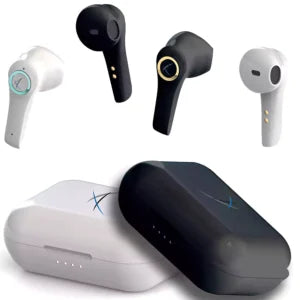Wireless headphones, safety and convenience for an essential option
Among the many technological accessories that accompany our smartphones there is one that is increasingly present, wireless headphones . 
Chosen for the convenience and safety they can guarantee, wireless headphones are now the safe choice made by many users.
Since the wireless headset is cordless, it guarantees more convenience in any context, from calls while driving to sports, from calls in the office to the great advantage of being able to make calls without using your hands, for multitasking that is sometimes necessary and possible.
This type of headset is not only used for telephone purposes but is designed for various uses:
Wireless headphones, types
It's easy to say wireless headphones , but the market divides them into at least three different form factors:
 In-ear
In-ear
Probably the most common model among the various types of wireless headphones . The in-ear headphones fit into the ear canal and use it and its specially designed shape to stay in place.
The headset can then occupy only the ear area or have two possible variants:
The main advantage of this headset is given by its miniaturization, which allows immediate and continuous portability, allowing you to use them on the move, at any time. The small size and minimal weight allow for excellent usability, for a product that can also be used for long sessions without tiring the user.
The disadvantage of this headset is its miniaturization. The limited dimensions do not allow for a driver that exceeds 10 millimeters. This minimum size therefore impacts noise isolation and audio quality, which does not reach that of the other two types of headphones .
On-ear
This type of headphone, known as monaural, is composed of a "sound cushion" that rests above the auricle. The absence of ear "hooking" systems and the weight of the headphones forces the adoption of a headband that passes over the head.
The on-ear format can be considered an intermediate model, thus guaranteeing good insulation given by a significant diameter (between 30 and 40 millimetres), although not perfect, given that the diameter does not allow perfect insulation of the auricle.
Over-ear
This last type of headphone is known in technical jargon as circumaural. The over-ear headphones are in fact the ones with larger dimensions, capable of covering the auricle in its entirety. Excluding the weight factor of the headband-pavilions combination, this headset can be considered as the most comfortable possible among the three types.
Convenience that is lost when it comes to storing or storing headphones , given that they take up a significant volume in their practically mandatory case.
However, the dimensions do not only ensure ease of use but also perfect insulation from external noise, thanks to pavilions that have an average size ranging from 45 to 60 mm.
Due to these characteristics, over-ear headphones usually have two types of use, very different from each other with each of them exploiting one of the strong points of the headphones:
We are therefore faced with an "umbrella term" which encompasses different types of products designed for different uses and needs.
How are wireless headphones made? 
There are obviously various components that make up a wireless headphone. In fact, we find the part relating to the casing, that of the headband and the "sponges" which make the use of the headphones comfortable and simple.
They also contain a Bluetooth connector and one or more microphones.
In addition to these elements, we then have the driver, the real heart of the headphones.
The function of this component is to convert the electrical signal into sound. To simplify, the driver can be considered as a small ear-friendly speaker.
The driver
A wireless headphone driver is a disk with a size that varies depending on the headphone itself. In this circle which can range from 6mm to 30mm we find three parts:
Driver type
There is not just one type of driver, but it is differentiated into different types, which are characterized by their intended use, size and cost. Here are the four most common types:
Dynamic drivers
They are among the most widespread drivers, they have a good sound balance and thanks to a large diaphragm they allow excellent bass with minimal energy consumption. Allowing for small dimensions, these drivers are often chosen for in-ear wireless earphones.
 Planar magnetic drivers
Planar magnetic drivers
In this type of technology a diaphragm is inserted between the magnets. This addition makes this driver a high-end product, used for high-value headphones . From a sound point of view, the generated signal is clean and neutral, letting it pass without altering any type of detail.
They are usually the ideal choice of audiophiles.
Electrostatic drivers
This is probably the least common type as it is quite expensive and always involves large dimensions. This type of driver uses electrostatically charged diaphragms.
This guarantees first-rate audio output for a high-priced but also high-quality final product.
Balanced structure driver
They are very small drivers made up of a set of drivers. Each of these micro drivers then acts on different frequencies thus generating minimal distortions.
Features of wireless headphones
There are various parameters that are considered in the manufacture and choice of a driver and consequently a wireless headphone, in particular:
Frequency response
This parameter defines the entire range of sound frequencies that can be reproduced by the headphones. The human ear can perceive frequencies ranging from 20Hz to 20000Hz, a range that wireless headphones try to stick to.
The complete coverage of this range is therefore the minimum value required, with some headphones going beyond the same, in order to guarantee better sound performance in the high, medium and low tones.
Sensitivity
This value indicates how the sound pressure of the headphones reacts to the applied voltage. This value is measured in Decibels and indicates the maximum level of sound that can be reproduced before any distortion.
Impedance
This value indicates the resistance exerted by the headphones on the audio signal. Value indicated in Ohm can range from 8 Ohm for low impedance ones up to 600 Ohm for high impedance ones. Low value headphones are normally used with small portable devices, high value ones are usually the prerogative of professional Hi-Fi systems and amplifiers.
Active Noise Cancellation 
Wireless headphones equipped with this innovative technology are equipped with small microphones that pick up environmental noise and balance it by reproducing it in out-of-phase. This balance leads to an almost total cancellation of noise which is replaced by an almost imperceptible background sound. The noise cancellation works very well, especially for a noise that repeats over time (the classic noise of an airplane engine) but it still needs to be improved for sudden noises.
Other important features of wireless headphones are the audio signal transmission system, which can be via infrared, radio waves or Bluetooth.
The first is quite common thanks to its cheapness, even if it only works best in static situations, as in the case of listening to the TV audio while sitting on the sofa. Radio wave headphones work well and have great range but are prone to interference. Finally, Bluetooth are the most common, also thanks to the chipset itself present by default in most devices.








